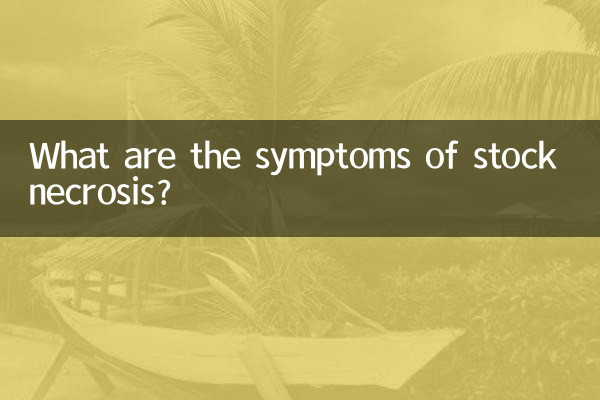What are the symptoms of stock necrosis?
Femoral necrosis, also known as femoral head necrosis or avascular necrosis of the femoral head, is a bone disease caused by insufficient blood supply to the femoral head. In recent years, with the improvement of health awareness, the symptoms and treatment methods of stock necrosis have become a hot topic. The following is a compilation of content related to stock necrosis that has been hotly discussed on the Internet in the past 10 days to help you fully understand this disease.
1. Main symptoms of femoral necrosis

Symptoms of femoral necrosis usually appear gradually as the disease progresses. The following are common clinical manifestations:
| Symptoms | Description |
|---|---|
| hip pain | It manifests as intermittent dull pain in the early stage, and may develop into persistent severe pain in the later stage, which is especially aggravated during activities. |
| Restricted activities | The range of motion of the hip joint is reduced, and lameness or difficulty walking may occur. |
| night pain | Some patients also experience pain while resting at night. |
| Muscle atrophy | Long-term illness may cause muscle atrophy in the affected thigh. |
2. High-risk groups for femoral necrosis
According to recent medical data, the following groups of people are more likely to develop stock necrosis:
| high risk groups | risk factors |
|---|---|
| chronic drinker | Alcohol interferes with fat metabolism and increases the risk of femoral head ischemia. |
| hormone users | Patients taking long-term high-dose glucocorticoids. |
| trauma patient | A hip fracture or dislocation can damage the blood supply to the femoral head. |
| patients with specific diseases | Such as sickle cell anemia, systemic lupus erythematosus, etc. |
3. Recently hotly discussed treatment methods for stock necrosis
In the past 10 days, the following treatment methods have sparked widespread discussion on medical forums and social platforms:
| Treatment | Features |
|---|---|
| Conservative treatment | Including medication, physical therapy and weight reduction, suitable for early stage patients. |
| core decompression | Surgery reduces the pressure within the femoral head and promotes blood circulation. |
| stem cell therapy | A hot topic recently is promoting the repair of necrotic areas through transplantation of stem cells. |
| artificial joint replacement | Effective solutions for end-stage patients, the technology is becoming increasingly mature. |
4. Preventive measures for femoral necrosis
According to recent health science content, you need to pay attention to the following points to prevent stock necrosis:
1.Control your drinking: Avoid long-term heavy drinking
2.Use hormones with caution: Use glucocorticoids strictly as directed by your doctor
3.protect hip joint: Avoid trauma and excessive weight bearing
4.Regular inspection: High-risk groups should undergo regular hip examinations
5.maintain a healthy weight: Reduce the burden on joints
5. Recent relevant hot events
1. The news that a well-known athlete retired due to stock necrosis triggered attention to sports injuries.
2. Research on the application of new biomaterials in the treatment of hip necrosis has made progress
3. Discussion of medical insurance coverage for treatment of femoral necrosis
4. Controversy over the effectiveness of traditional Chinese medicine acupuncture therapy in the adjuvant treatment of femoral necrosis
6. Expert advice
Recently, many orthopedic experts emphasized in media interviews:
• Early diagnosis and treatment are critical to prognosis
• People aged 40-50 should be vigilant if they experience unexplained hip pain
• Treatment selection needs to be determined based on the stage of the disease and individual patient circumstances
• Postoperative rehabilitation is equally important and functional exercises must be carried out as directed by the doctor.
Understanding the symptoms and treatments of femoral necrosis can help with early detection and timely intervention. If you or your family members develop related symptoms, it is recommended to go to the orthopedics department of a regular hospital as soon as possible to receive professional diagnosis and treatment.

check the details

check the details